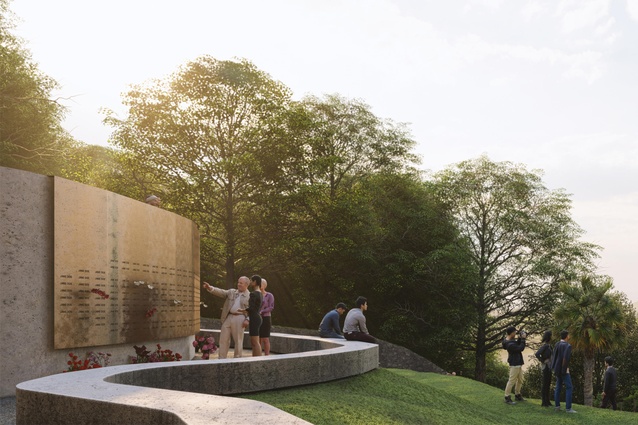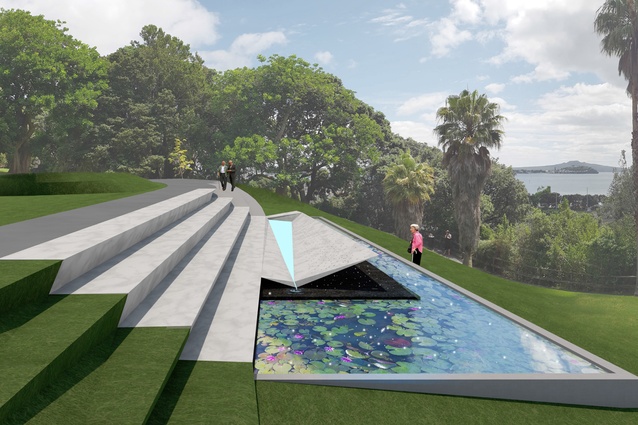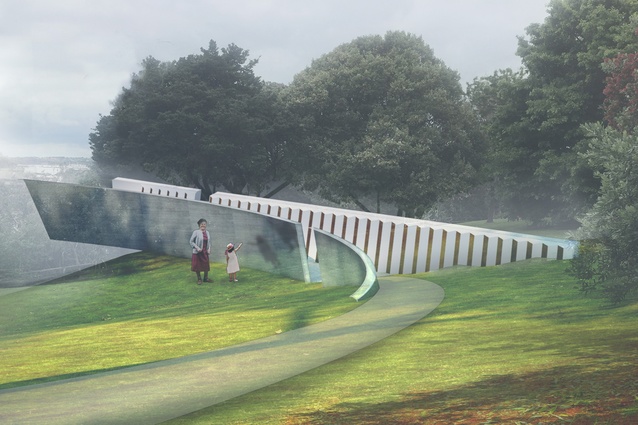National Erebus Memorial concept designs revealed
Concept designs for a new National Erebus Memorial have now been submitted to Manatū Taonga Ministry for Culture and Heritage, says chief executive Bernadette Cavanagh. “Six anonymous design teams selected in December were asked to submit concept designs.”
“The designers were provided with comments from the families of the Erebus victims and given the opportunity to talk to some family members in this phase of the process,” Cavanagh continues.
“Feedback from the families on the designs will be presented to the National Erebus Memorial Design Panel when they meet in March to evaluate the designs. The Panel will be recommending the finalist to the Prime Minister.” Two Erebus family members (yet to be selected) will be joining the Design Panel in March, with the winning entry announced in May.
Cavanagh notes, “It’s a significant milestone and provides a real sense of the progress of this project.”
The 40th anniversary of the Erebus accident will be marked in November this year, with a Memorial planned to be established in early 2020.
See the concept designs below with descriptions from the teams.
Proposal 006

Creating connections is a key outcome for this project. We look to the land for connection, orientation and direction. We pay homage to the ancient Mountains of Antarctica and the younger volcanoes of Aotearoa and Auckland, and acknowledge the separation of our lands by water. We acknowledge Mt Erebus as the tuakana (elder) and Rangitoto as the teina (younger). This also speaks to the spiritual connection the younger, present generations have to those who have departed.
The Mauri Stone concept has been part of voyaging cultures for a millennium and we want to acknowledge the customs of navigators past and present. The design proposes to utilise stone from Erebus and Rangitoto as a centre piece in the memorial to acknowledge both lands, the Mauri Stones will be carved by Mana Whenua artists to create another deeper connection to our indigenous culture. Over time the Mauri Stones will adapt and change through the touch of human hands. This is how visitors can touch, feel, and become part of the memorial.
The Mauri Stones sit at the centre of an Azimuthal Map, centred on Antarctica. This ‘upside down’ view of the world relates to how the world was turned upside down for the family members of those lost in the Erebus tragedy. This also resonates within Te Ao Māori where an upside down view expresses a different perspective, a change to the way we think, see and understand the world. Directional connections on the Azimuthal Map are created in stone sourced from each country as a further acknowledgement of the losses shared by others.
The Māori concept of love is intertwined throughout the memorial through the metaphor of a korowai or cloak. As a whole element the memories will be protected by the enveloping of He Korowai Aroha. The outer edge encircles the memories, and the inner edge allows us to acknowledge the pain of loss. Finally, there is lightness, as the memories are released upwards into the air.
Proposal 005

Maunga/Kōhanga – Mountain/Nest
The cold, remote, and sublime Antarctic landscape seems far away from Auckland’s lush and green parks. Mount Erebus comes to mind as a hostile, malevolent presence. How can a memorial bring this landscape close? How can this place embody empathy for the victims and connect with the mountain where they lost their lives? The concept for Maunga/Kōhanga is of Mount Erebus travelling north to these shores, and rotating to become a welcoming nest.
Mount Erebus’s topographical contours, from the opposite side of the mountain to the crash site, create the nest: a grass amphitheatre. The top terrace is backed by a concrete wall, with four bronze panels draped over it, carrying information about the Tragedy; a whakataukī; the poem ‘Erebus Voices’; the 257 victims’ names; and gratitude for those who helped in recovery and identification.
Passenger and crew names are configured in the seating plan for flight TE 901, capturing the meaningful connections between people as they made their exciting journey to Antarctica. The amphitheatre is a flexible space for formal civic functions, performances and exhibitions of Antarctic music and art, and a welcoming place for everyday visitors.
It is a place to enjoy the view, to reflect on the Erebus Tragedy and on one’s own experiences of loss and adversity. To lie back on the grass banks and watch the clouds in the sky … to sit on the grass terraces and stare in the distance… An axis cut through the wall and expressed on the ground points to Mount Erebus; everyone entering or leaving through the formal entry is momentarily aligned with the mountain. And an Erebus boulder sits next to the axis, on the seat, inviting a tactile engagement with the distant mountain, a reverberation between here and there.
Proposal 004

On entering the Te Maunga Huka National Erebus Memorial visitors are greeted with a natural amphitheatre that slopes gently towards the Waitemata. An enclosure of trees draws attention skyward. It is at once intimate and vast, and honours both this special site and those lost in the tragic event at Mount Erebus.
A terrace of steps carved into the landscape provides a sitting or standing platform for contemplation. The names of those lost in the accident are engraved on a white sloping surface which is read from the steps. Amongst the names, the shard form is pierced with holes, evoking a new constellation of stars.
One star for each person lost. Sunlight penetrates the holes and shines onto a black granite pool below. This sculptural shard represents the slopes of Erebus as well as the shock and finality of the event. Pure water falls gently from it into the dark body of water over which it hovers.
A third pond embraces the whole and is filled with water lilies and fish representing life. At night this lily pond is illuminated from below by the Ara constellation seen in the Southern Hemisphere sky. A Mauri Stone from Mount Erebus is placed in the pond.
The use of stars, is a symbolic offering to provide clear vision for navigation and guidance to return the people homeland (Hawaiki). It also makes reference to the notion of people becoming stars when passing over. A number of constellations are proposed. Represented here is not only the shock of the accident as a shard, but the hope and healing brought to us in the stars and new life of the lilies.
Proposal 003
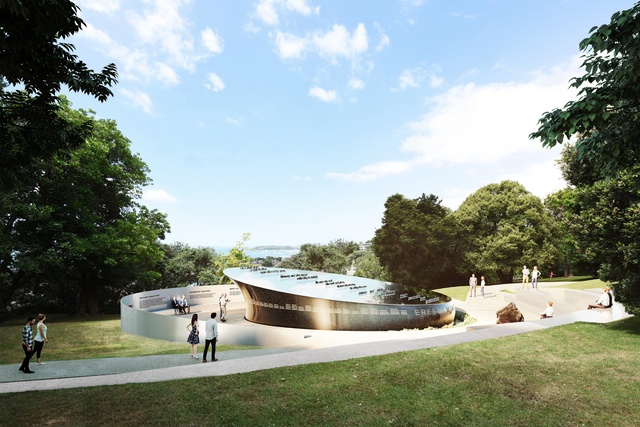
In a verdant harbourside park, overlooking Taurarua (Judges Bay) to Maungauika (North Head) and Rangitoto, a new geological formation emerges from the gently sloping field – a metamorphic bedrock of memory, commemoration and knowledge – New Zealand’s National Erebus Memorial. A prominent New Zealand Poet has written a poem specifically for this important national project.
Rising from the carved and eroded ground plane, two geological entities sit in balance. Way Point and Erebus Terrace. One evokes the enormity of the Erebus accident, an event that buoyantly began with a promise of adventure but ended with incalculable loss and deep sorrow. The other contains a stone excavated from the ground on which the accident happened, a tangible fragment of place, a conduit to a time and place that few have or will ever visit.
Way Point, in words evokes a sparse, vast emptiness – an allusion that captures both a sense of Antarctic geography and emotional desolation. Its sky-reflecting monolithic form, a physical expression of the accidents weighty impact, focuses the view outward and upward to distant harbour views and the vast expanse above. Presenting an opportunity for the mind to expand into the void – to contemplate the accidents many facets. Looking to infinity, blending with the natural surrounding beauty, it is uplifting and forward focused.
At a more intimate scale, the Erebus Terrace, represents a physical connection to the site of the accident. Orientated on the axis south toward Mt Erebus, it presents a place that reflects upon the location and all the lives lost. Cut into the ground and cloaked by a shield that buffers the noise of the city and nurtures an environment of quiet contemplation. A stone from Mt Erebus is placed upon the ley line to Antarctica offering a fragment as a touchstone at the foot of the poem.
Proposal 002

This project undertakes not just the responsibility for the physical form of the memorial but a holistic process which offers opportunities for the families’ involvement from now, to its opening and beyond. With support from mana whenua we wish to invite the families to walk alongside us, to share stories, to share karakia and rituals. We wish for these moments to create the time and memories that are needed for the families to understand the gift of this already sacred place; one that includes the private moments of reflection as well as a public recognition of the loss that impacted on our nation. We want this to be a place that they can come to see as their own.
The physical experience is itself a journey through the waharoa (gateway) which presents the basic facts and marks this as a place of significance. It provides a guided journey that allows visitors time to contemplate the many names as people and loved ones. The story itself is told through the voices of the family marked. In hearing a range of expressions that speak different truths, we can create one in common. This creates a historical account through the voices of the people, to be shared with generations to come.
The physical journey is accompanied by soft terraces of planting so when in the space you always look over regenerating life to the significant views beyond. The journey ends with the white terraced walls coming together to form a physical expression that reflects the Antarctic, one that is vast and endless. Here we are given an opportunity to acknowledge the recovery team alongside all the seen and unseen heroes that wrapped around the families as this tragedy rippled through the nation.
Proposal 001
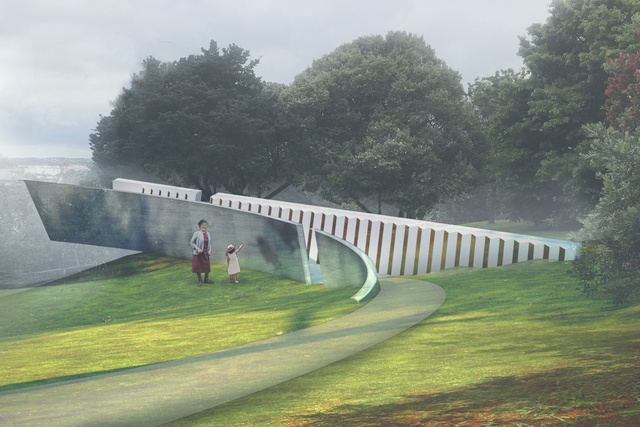
Te Paerangi Ataata; Sky Song
The horizon connects us, defying time and space.
For here, in this ancient place, we are standing together.
All the way south. We are connected.
Ahakoa te tāwhiti, kua tūhonongia a tāua e te pae nei.
I tēnei wāhi onamata, e tū ana a tāua inaianei.
Ki te tai tonga rā āno, kua tūhonongia a tāua.
Touching lightly on the sacred clearing above the Judge’s Bay Taurarua and reflecting its setting through its mirror-like finish ‘Te Paerangi Ataata; Sky Song’ projects boldly outward to the horizon and connects us to a different time and place through the concept of a shared sky.
We look to the sky, and that sky is connected to the sky over Antarctica. The families waited and looked out to the sky, the lost departed into the sky, and their adventure was in the sky.
The concept is the experience of the visitor as they approach and venture along the walkway to the horizon, and as the story of what happened on that tragic day unfolds.
The movement out to the horizon, openness, and the sky represents the journey and adventurous spirit of the crew and passengers towards the unknown and the future: a celebration of life.
The movement back to the land reveals the reverse face of the Ice Wall and presents the names of those who lost their lives in the tragic event.
The story is told by the forms and materials of the curving Snowdrift Wall, and the imposing Ice Wall, the lyrics of a song, and an Erebus Narrative. The Memorial is linked to Antarctica by form and colour, and a listening place where the sounds of Antarctica resonate from the Ice Wall.
‘Te Paerangi Ataata; Sky Song’ speaks of adventure, and tragedy, joy and grief.
A version of this article was first published on the Landscape Architecture Aotearoa website, which is published by the New Zealand Institute of Landscape Architects (NZILA).


